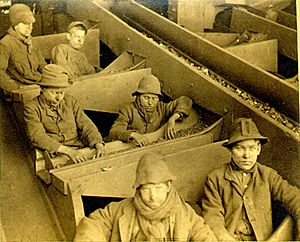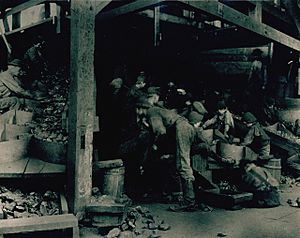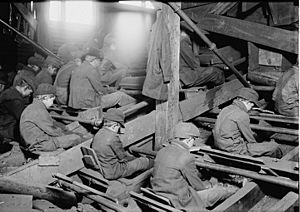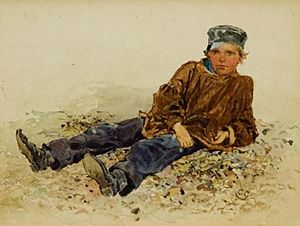Breaker boy facts for kids

A breaker boy was a young worker in coal mines, mainly in the United States and United Kingdom. Their job was to separate dirt and rocks from coal by hand. This work happened in a building called a coal breaker. Most breaker boys were children, but sometimes older miners who couldn't work underground anymore also did this job. Breaker boys started working around the mid-1860s. Even though many people thought it was wrong for children to do this work by the 1880s, the practice didn't fully stop until the 1920s.
Contents
What Was Coal Breaking?
Coal became very important in the late 1500s in the United Kingdom. This happened after many forests were cut down. King Charles I of England even banned cutting wood so forests could be saved for the Royal Navy. People needed new fuel.
Around this time, more people wanted glass for windows. Glass factories used a lot of charcoal for fuel. With less wood, they switched to coal. Coal was also needed for new inventions like the reverbatory furnace, which helped make iron objects like cannons.
How Coal Was Processed
The first step in a coal breaker was to smash large pieces of coal into smaller, similar-sized chunks. This was called "breaking." But coal often came mixed with unwanted stuff like rock, slate, dirt, and ash.
So, the second job of a coal breaker was to remove these impurities. The goal was to make the coal as clean as possible. This cleaning became very important when factories started using huge amounts of coal. Clean coal burned much better and caused fewer problems.
Before 1830 in the US, miners would break large coal lumps with a sledgehammer. They used a rake to collect bigger pieces. Smaller pieces were often left behind. Later, machines and screens were used to sort coal. This "broken and screened" coal was much more valuable because it burned more evenly.
Life as a Breaker Boy

Until about 1900, most coal cleaning in the United States was done by hand. This job was usually done by breaker boys, who were often between 8 and 12 years old.
For ten hours a day, six days a week, breaker boys sat on wooden seats. They were perched over fast-moving chutes and conveyor belts. Their task was to pick out pieces of slate and other impurities from the coal.
Some boys would stop the coal flow with their boots. They would quickly pick out the bad pieces. Then they let the coal move on to the next boy. Others would direct coal into a side chute. They would clean it there before letting it fall into "clean" coal bins.
Dangers of the Job
Working as a breaker boy was very dangerous. The boys had to work without gloves. This was so they could feel the slick coal better. But the slate was sharp, and their fingers often got cut and bled.
Sometimes, their fingers were even cut off by the fast-moving conveyor belts. Many boys suffered serious injuries. Some of these injuries were so bad that they led to death. The air was also full of coal dust, which was terrible for their lungs.
Why the Public Disapproved

Many people were very upset about children working as breaker boys. In 1885, Pennsylvania passed a law. It said no one under 12 could work in a coal breaker. But this law was not enforced well. Many employers and families lied about children's ages. Families often needed their children to work to help earn money.
It's hard to know exactly how many breaker boys there were. Some guesses say there were 20,000 in Pennsylvania in 1880. By 1907, there might have been 24,000.
The End of Breaker Boys
In the 1890s and 1900s, new machines were invented. These machines could remove impurities from coal using water or mechanical parts. This greatly reduced the need for breaker boys. However, it took time for these new machines to be used everywhere.
By the 1910s, fewer children were working as breaker boys. This was because of better technology and stronger child labor laws. Also, laws for compulsory education meant children had to go to school.
The practice of using children in coal breakers mostly stopped by 1920. Groups like the National Child Labor Committee, along with people like Lewis Hine (a photographer), helped show the public how bad the conditions were. Their efforts led to national laws against child labor.
Breaker Boys and Unions
Breaker boys were known for being very independent. They often didn't like being told what to do by adults. Many breaker boys joined trade unions. They even started important strikes in the coal fields of Pennsylvania.
These strikes included the one that led to the Lattimer massacre. They also played a part in the big Coal strike of 1902. These actions showed that even young workers could fight for better conditions.


